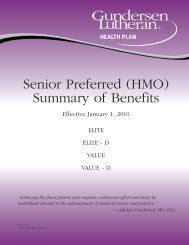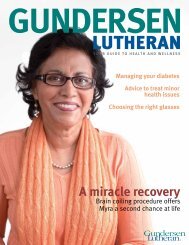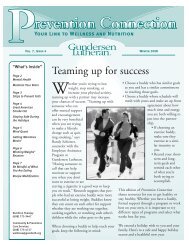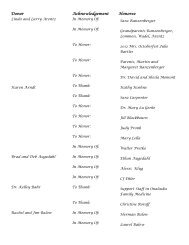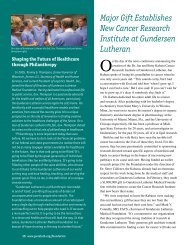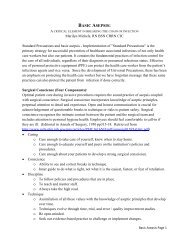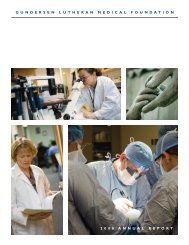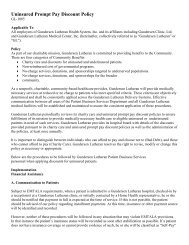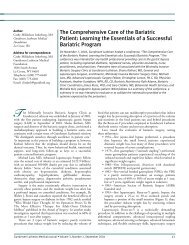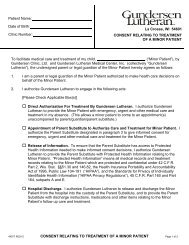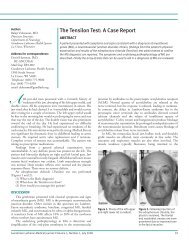ndersen er an - Gundersen Health System
ndersen er an - Gundersen Health System
ndersen er an - Gundersen Health System
You also want an ePaper? Increase the reach of your titles
YUMPU automatically turns print PDFs into web optimized ePapers that Google loves.
Author:<br />
Balaji Vishw<strong>an</strong>at, MD<br />
Physici<strong>an</strong> Em<strong>er</strong>itus,<br />
Department of Neurology<br />
Gu<strong>nd<strong>er</strong>sen</strong> Luth<strong>er</strong><strong>an</strong> <strong>Health</strong> <strong>System</strong><br />
La Crosse, Wisconsin<br />
Address for correspondence:<br />
David Hartm<strong>an</strong>, PhD,<br />
BC-ANCDS(A)<br />
Mail Stop EB3-002<br />
Gu<strong>nd<strong>er</strong>sen</strong> Luth<strong>er</strong><strong>an</strong> <strong>Health</strong> <strong>System</strong><br />
1900 South Avenue<br />
La Crosse, WI 54601<br />
Telephone: (608) 775-9000<br />
Fax: (608) 775-6358<br />
email: dehartma@gundluth.org<br />
The Tensilon Test: A Case Report<br />
Abstract<br />
A patient presented with symptoms <strong>an</strong>d signs consistent with a diagnosis of myasthenia<br />
gravis (MG), a neuromuscular junction disord<strong>er</strong>. H<strong>er</strong>ein, findings from the patient’s physical<br />
examination <strong>an</strong>d results of the edrophonium chloride (Tensilon) test administ<strong>er</strong>ed to confirm<br />
the MG diagnosis are reported. The symptoms <strong>an</strong>d und<strong>er</strong>lying pathophysiology of MG are<br />
described. Finally the array of tests that c<strong>an</strong> be used to aid in a diagnosis of MG are reviewed.<br />
A<br />
68-year-old m<strong>an</strong> presented with a 2-month history of<br />
weakness of his jaw, drooping of his left upp<strong>er</strong> eyelid, <strong>an</strong>d<br />
double vision. All his symptoms w<strong>er</strong>e int<strong>er</strong>mittent in nature. His<br />
jaw tired aft<strong>er</strong> he had chewed 3 or 4 mouthfuls <strong>an</strong>d would recov<strong>er</strong><br />
aft<strong>er</strong> resting for a couple of minutes. The left upp<strong>er</strong> eyelid would<br />
be fine in the morning but would start drooping by noon <strong>an</strong>d stay<br />
that way the rest of the day. The double vision was also prominent<br />
toward the end of the day. He had exp<strong>er</strong>ienced no difficulty<br />
swallowing or breathing. He had exp<strong>er</strong>ienced no weakness of his<br />
neck muscles. His extremities w<strong>er</strong>e p<strong>er</strong>fectly strong. Medical history<br />
was signific<strong>an</strong>t for rheumatic fev<strong>er</strong> in childhood leading to aortic<br />
stenosis. He required aortic valve replacement <strong>an</strong>d 2 revisions.<br />
Complete review of systems was unremarkable. The patient was<br />
taking no prescription medications.<br />
Findings from a gen<strong>er</strong>al physical examination w<strong>er</strong>e<br />
unremarkable. A v<strong>er</strong>y definite ptosis was present on the left. The<br />
patient had binocular diplopia on right <strong>an</strong>d left lat<strong>er</strong>al gaze. Jaw<br />
muscles w<strong>er</strong>e normal but easily fatigued. Mild bilat<strong>er</strong>al low<strong>er</strong> motor<br />
neuron facial weakness was evident. Limb musculature strength<br />
was normal. Deep tendon reflexes w<strong>er</strong>e normal <strong>an</strong>d the pl<strong>an</strong>tar<br />
responses flexor. Th<strong>er</strong>e w<strong>er</strong>e no sensory deficits.<br />
An edrophonium chloride (Tensilon) test was p<strong>er</strong>formed<br />
(Figures 1 <strong>an</strong>d 2).<br />
(1) What is the likely diagnosis?<br />
(2) What does the Tensilon test show?<br />
(3) How would you m<strong>an</strong>age this patient?<br />
junction by <strong>an</strong>tibodies to the postsynaptic acetylcholine receptors<br />
(AChR). Normal qu<strong>an</strong>ta of acetylcholine are released at the<br />
n<strong>er</strong>ve t<strong>er</strong>minal, but the response is reduced, leading to weakness.<br />
In contrast, the defect in Lamb<strong>er</strong>t-Eaton syndrome lies in the<br />
presynaptic n<strong>er</strong>ve t<strong>er</strong>minals due to <strong>an</strong>tibodies directed toward<br />
calcium ch<strong>an</strong>nels <strong>an</strong>d the release of insufficient qu<strong>an</strong>ta of<br />
acetylcholine. 1 Cobra venom <strong>an</strong>d bungarotoxin produce blockage<br />
of neuromuscular tr<strong>an</strong>smission by prolonged nondepolarization of<br />
the neuromuscular junction. Botulinum toxin causes blockage of<br />
acetylcholine release from n<strong>er</strong>ve t<strong>er</strong>minals.<br />
In MG, the extraocular, facial, jaw, bulbar, neck, <strong>an</strong>d should<strong>er</strong><br />
girdle muscles are affected, most commonly in that ord<strong>er</strong>. The<br />
extremity <strong>an</strong>d respiratory muscles are also often involved. The<br />
muscle weakness typically fluctuates, being minimal in the<br />
DISCUSSION<br />
This gentlem<strong>an</strong> presented with classical symptoms <strong>an</strong>d signs<br />
of myasthenia gravis (MG). MG is the prototypic neuromuscular<br />
junction disord<strong>er</strong>. Oth<strong>er</strong> entities in this spectrum are Lamb<strong>er</strong>t-<br />
Eaton myasthenic syndrome, botulism, congenital MG, familial<br />
inf<strong>an</strong>tile MG, <strong>an</strong>d envenomation by cobra or alpha-bungarotoxin.<br />
A tr<strong>an</strong>sitory form of MG affects 10% to 20% of the newborns<br />
whose moth<strong>er</strong>s have autoimmune MG.<br />
The und<strong>er</strong>lying pathophysiology in MG is distortion <strong>an</strong>d<br />
simplification of the end-plate membr<strong>an</strong>e in the neuromuscular<br />
Figure 1. Ptosis of the left upp<strong>er</strong><br />
<strong>an</strong>d right low<strong>er</strong> lid is evident.<br />
Figure 2. Following injection of<br />
the edrophonium chloride, the<br />
ptosis is resolved. The frontal<br />
<strong>an</strong>d nasolabial creases are more<br />
prominent due to improved tone<br />
in the facial muscles.<br />
Gu<strong>nd<strong>er</strong>sen</strong> Luth<strong>er</strong><strong>an</strong> Medical Journal • Volume 5, Numb<strong>er</strong> 1, July 2008 19




